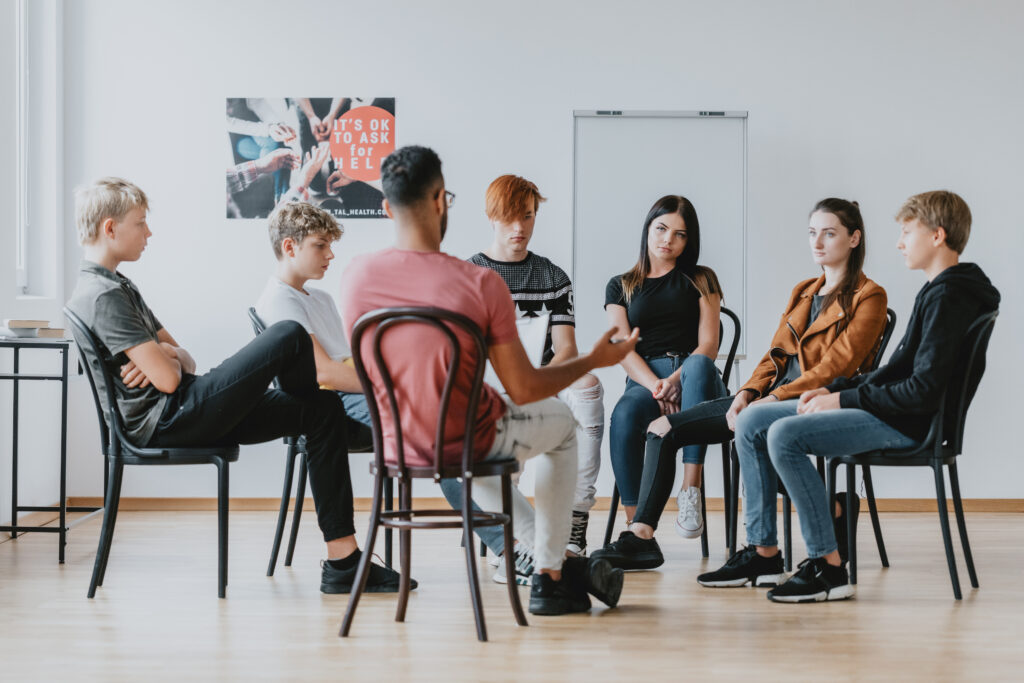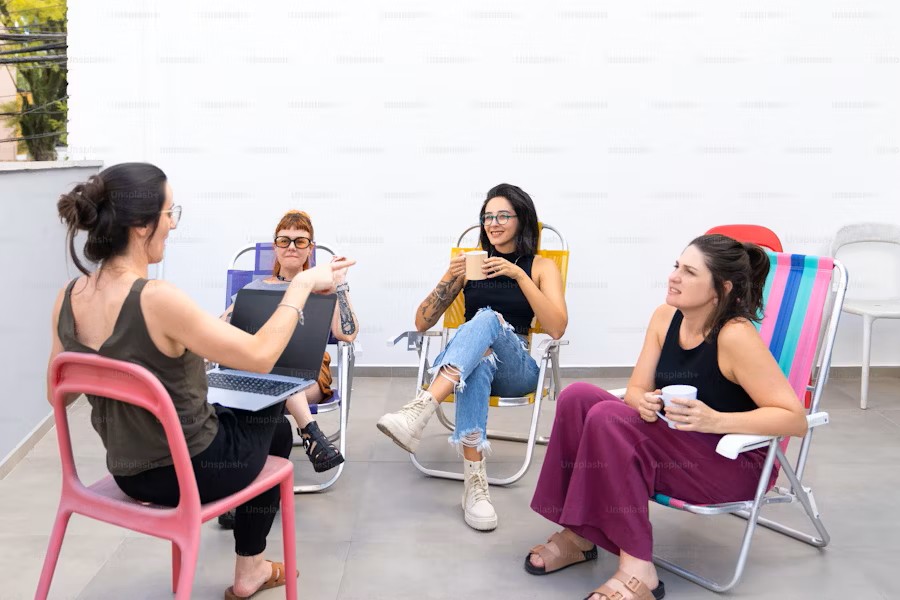Application of the Proposed Program
The first stage of this proposed program would be to adopt a client-centered approach by talking to families and children about the needs they have as a result of witnessing or being the victims of the natural disaster. The families themselves are the best source of information as to how their children can benefit from participating in a therapy group. It is especially important to ask the children – the group participants – what their own goals would be in participating in the group and what their personal expectations of the group may be. When children have already been traumatised, and made to feel powerless, it is particularly important to empower them by listening to their opinions and wishes, informing them of each step of the process and always letting them know that they have the choice to either participate or not.
The second stage of the program would be to interview staff at the children’s agency or school where the proposed program would take place, about the problems they see need to be addressed in relation to children who have been traumatised by the natural disaster. The staff who work with the children and families are well placed to inform the practitioner coordinating the program as to areas of concern that participating in a therapeutic group my help. It is also useful when doing initial assessments for ‘counsellors to ask parents, other relatives and teachers whether children’s behaviours would be considered normal for a given child prior to the disaster’ (Baggerly and Exum, 2007, p. 81).
Following the planning process, the sessions themselves can now be developed with the benefit of information from the families, children and staff as to what will be most helpful. The meeting place will ideally be a quiet room which has a limited number of tables and chairs and can be set up as a dramatherapy room with space for the group to move about. To maintain privacy the room should be in a part of the agency or school that cannot easily be disturbed by other staff, children or family members if possible.
The sessions will be run as a group rather than individual counselling sessions. Herman (1992) noted that ‘the core experiences of psychological trauma are disempowerment and disconnection from others’ (Kasiram and Khosa, 2008, p. 230). As a result, ‘recovery…has to extend beyond the individual if sustained change is to be promoted (Kasiram and Khosa, 2008, p. 230). Group-work provides an opportunity for the participants to connect with each other, with the goal of building social skills, trust and group-support. One of the main emotions experienced by children who have experienced trauma is fear, which also makes the collaborative and supportive nature of group-work an appropriate choice of therapy.
When planning a program for a group of children who have experienced a traumatic natural disaster, the following aspects are ones that should be considered essential for the running of the group. The first aspect is to be ‘especially careful to create conditions of safety’ (Jennings: 1995, p. 182). For this reason, it is necessary to work with the group members in making contracts and having guidelines regarding how the group will run, as boundary-making for young people who have disrupted boundaries is essential (Jennings, 1995, p. 182).
A further and most important area of safety for a group of children who have been traumatised is that they should not feel re-traumatised within the group…[and]…this aim takes precedence over an individual’s need for a cathartic reaction (Jennings: 1995, p. 182). This can be achieved by having clear boundaries around how and when each child’s own traumatic experiences are disclosed, empowering each child to stop participating at any time in the group and having good closure at the end of each session where the participants have choice over how the groups ends. It is also going to assist in keeping the children safe by having an assistant in the group who can work one-on-one with a child if that child is feeling uncomfortable or unsafe in any way.
The second aspect to consider is the level of trust, as the ‘therapist’s first task is to work toward establishing a strong therapeutic relationship based on trust and respect’ (Weber and Haen, 2005, p. 142). This can be done through trust exercises and drama games at the beginning of each session. The level of trust in the group between clients and therapist, and clients with each other, can be monitored through the use of trust exercises, such as one half of the group building an obstacle course in the room from furniture or large objects and the other half of the group being led verbally through it while closing their eyes. For children who are traumatised closing their eyes may be difficult or threatening, so exercises such as this should be monitored closely by the Dramatherapist and not pursued if members of the group are uncomfortable doing them. The level of trust the group members have in each other, and in the therapist, will be identifiable in how well trust exercises are played by the group and how willing the group is to participate.
The strengths-based approach of dramatherapy has been observed to be very effective with clients who have experienced trauma. Dramatherapy ‘utilizes all the aspects of drama that are potentially healing…[as]…the creativity of drama is used to gain a greater understanding of self, as unconscious feelings, thoughts and issues come to the surface and are expressed through metaphor’ (Langley: 2006, p. 13). It is the role of the Dramatherapist to ‘facilitate the client’s progress through an appropriate dramatic experience that will allow healing to take place’ (Langley: 2006, p. 14). Using a dramatherapy approach would be beneficial as a therapeutic method for this population. Weber and Haen (2005) state that ‘many children who have experienced trauma…develop a damaged and distorted sense of self…[however]…drama therapy interventions offer these children an opportunity to explore other, more positive aspects of themselves, to identify strengths, and to move beyond their past behaviours’ (Weber and Haen, 2005: p. 145).
Therefore, through the use of dramatherapy activities, which children do naturally through their own play, can assist children who have experienced trauma to develop a stronger and more positive sense of self. As well as drama, the use of specific play therapy would also be very effective as, quoting Kot, Landreth and Giordana, (1998), and Tyndall-Lind, Landreth and Giordano (2001), Thompson acknowledges that research indicates that group play therapy is an effective mode of treatment with children who have been exposed to trauma (Thompson, 2011, p. 179). Children readily accept the dimensions and language of play as it is a natural method of developmental growth. Play and dramatherapy then, are non-confrontational methods of working therapeutically with children.
References
Baggerly, J. and Exum, H. (2007) Counselling Children After Natural Disasters: Guidance for Family Therapists, The American Journal of Family Therapy, 36:1, 79-93.
Jennings, S. (Ed.) (1995) Dramatherapy With Children and Adolescents, East Sussex: Routledge.
Kasiram, M. and Khosa, V. (2008) Trauma Counselling: Beyond the Individual, International Social Work, 51:2, 220-232.
Langley, D. (2006) An Introduction to Dramatherapy. London: Sage Publications Ltd.
McDermott, B. and Cobham, V. (2014) A stepped-care model of post-disaster child and adolescent mental health service provision, European Journal of Psychotraumatology, 5:1, 1-10.
Overstreet, S., Salloum, A., Burch, B. and West, J. (2011) Challenges Associated with Childhood Exposure to Severe Natural Disasters: Research Review and Clinical Implications, Journal of Child and Adolescent Behaviour, 4:1, 52-68.
Pfefferbaum, B., Noffsinger, M., Wind, L. and Allen, J. (2014) Children’s Coping in the Context of Disasters and Terrorism, Journal of Loss and Trauma, 19:1, 78-97.
Thompson, E., H. (2011) The Evolution of a Children’s Domestic Violence Counselling Group: Stages and Processes, The Journal for Specialists in Group Work, 36:3, 178-201.
Weber, A. M. and Haen, C (Eds.) (2005) Clinical Applications of Drama Therapy in Child and Adolescent Treatment, New York: Brunner-Routledge.








